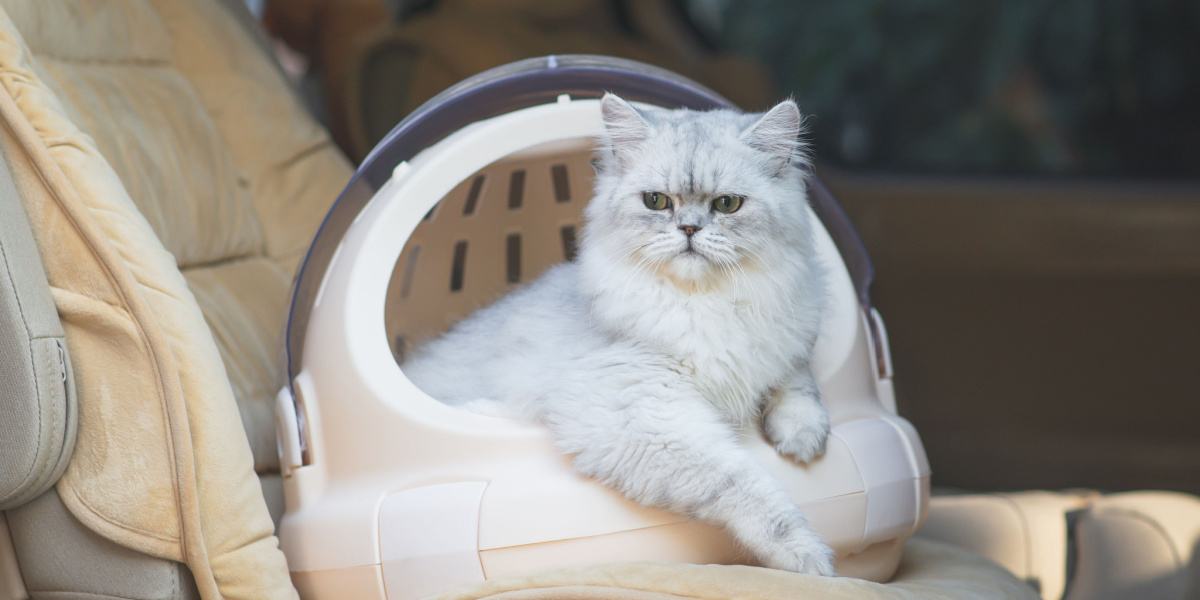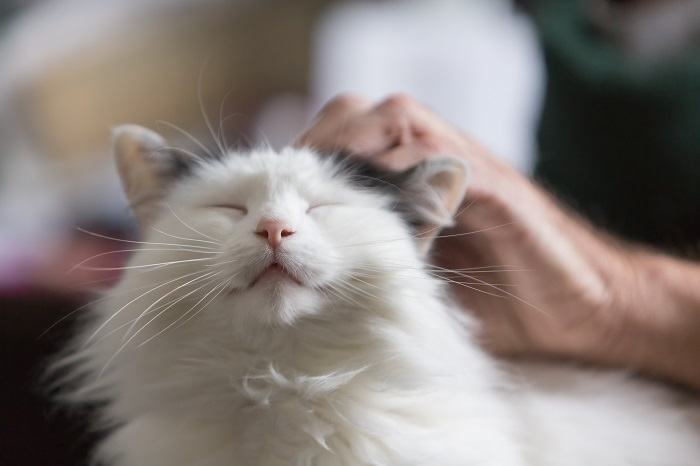
From a short trip along the coast or a longer journey for a house move, road trips are an opportunity for adventure. So, how can you allow your cat to join in the fun?
The good news is that your feline friend can come along, and it’s possible to make road trips with a cat fun and safe for everyone involved. Read on for useful tips to help make the road trip as smooth and stress-free as possible for both you and your cat.
5 Useful Tips for Road Tripping With Your Cat
Before you take your cat on a trip, there are some important factors to consider first. We’ve compiled 5 useful travel tips below that will help with any journey.
1. Use an Appropriate Carrier Box
Our first tip is to use an appropriate carrier box. This may seem like an obvious point but it isn’t. A small carrier might be ok for short drives (e.g. a 10-minute trip to the vet), but for longer journeys, this won’t be big enough. For any long-distance journeys, your cat needs a bigger space to move around in.
This could be a bigger carrier box or even a small dog crate. They should have access to a water bowl and a comfy cat bed. Some larger carriers/crates will fit a small litter box in case your cat needs a bathroom break on the way. They will definitely appreciate the option!
Pet carriers or crates should be in a safe, secured part of the car. They can be placed in the foot well of the car or on a seat secured with a seatbelt. If the car stops suddenly, the box needs to be secured well so that it doesn’t move.
Whatever box you decide to transport your cat in, it needs to have good ventilation and not be too hot/cold inside. Never transport your cat loose in the car. I know it seems kinder to let them out of the box, but it’s far too dangerous to have them unsecured in a vehicle. For your cat’s sake and yours, keep them in a carrier!
2. Reduce Their Stress

Take steps to reduce the stress your cat experiences during the road trip.
Many of us enjoy road trips, and it’s possible for our cats to enjoy them too. However, not all cats will enjoy them. They might even find them very stressful initially. To make the experience as positive and stress-free as possible, there are a few things you can try;
- If you plan on taking your cat in the car regularly, build it up slowly. For example, start with very short 5-minute journeys, and build this up gradually so your cat can get used to it. If possible, don’t take them on a long car journey without getting them used to shorter car journeys first.
- Using pheromone sprays (e.g. Feliway) on their bedding and blankets can help to reduce their stress. Spray this at least 30 minutes before the journey, without the cat present.
- Use a light blanket to cover the top of the carrier, or partially cover it if it’s a large carrier/crate. This will provide the cat with privacy and block out visual stimulation which could cause stress. Be careful not to fully cover the carrier as you could prevent proper air ventilation in the carrier.
- For cats that like catnip, you can sprinkle some of this on their favorite blanket or toy in the box. If you don’t know if your cat likes it, try them with a small amount in advance of the trip. Some cats act very relaxed with catnip while others can get a bit overexcited or hyper. You should only use it for car journeys if it relaxes your cat and makes them happier.
- Get advice from your veterinarian if you need to go on a long car journey (e.g. moving to a new home) and you know that your cat gets very stressed in cars. They might prescribe medication to relax your cat or relieve anxiety for the journey.
3. Treat Motion Sickness

Like people, cats can feel motion sick during road trips.
Similar to many humans, cats can feel sick during car journeys. This is also known as motion sickness. If your cat is feeling sick during the car journey, you might notice them excessively drooling which may be followed by vomiting. They might also be vocalizing loudly.
To help with motion sickness start with very short, calm car journeys. Build this up gradually if the motion sickness improves. If the sickness is severe and you really need to bring your cat in the car (e.g. a veterinary visit or house move) speak to your vet. There is motion sickness medication available that your vet can prescribe if they think that it’s appropriate for your cat.
4. Take Breaks
If you’re going on a long road trip, it might be worth breaking up the journey. Many hotels are pet-friendly hotels nowadays, and it could give your cat the chance to stretch their legs for the night.
If you’re going on a shorter road trip that doesn’t require an overnight stay, you can still take breaks during the drive. If your car is parked in a safe area off the main road, the engine is switched off and doors/windows closed, you could allow your cat out of the carrier for a break.
Never allow your cat to go outside of the car.
This is commonly done with dogs to give them fresh air and allow them to toilet. The difference is that dogs are on leads while cats usually aren’t, and they could easily run off in a new environment.
Some cats are harness trained and used to going outside on their lead, but I would still take care if you’re in a noisy area close to the main road. They could get spooked and slip their lead/harness.
5. Create a Calm Car Environment
Lastly, try to keep the environment in the car relaxing. This can be done by paying attention to a few points;
- The music shouldn’t be played loudly, and voices should be kept gentle and at a low level. Any excessive noise could make your cat stressed.
- Be mindful of the temperature of the car. Extreme heat/cold could have very serious consequences for your cat and could result in an emergency veterinary visit!
- Try to drive carefully and avoid speeding, swerving, or taking corners very fast. Any erratic driving will make the car experience very negative for your cat.
- Ensure that there is adequate ventilation in the car and that it’s not too stuffy. Particularly if there are a few people in the car.
- If you are bringing more than one pet on a road trip make sure they have their own space. Don’t put cats in the same carrier and if possible, don’t have them facing each other. Even if they get along under normal circumstances, they might not if they’re feeling stressed during the car journey. Keep any dogs away from a cat in a carrier as this could be intimidating for the cat.
The Road Trip Exceptions

Every cat is different, and whether or not your cat can go on road trips depends on their personality.
It’s important to note that every cat is different and they’re creatures of habit that don’t like change. Some cats will adapt well to travelling in a car with the above tips. They could be the ideal road trip partner. On the other hand, some cats are very prone to stress and anxiety. This could become a lot worse during a car journey especially a long trip. For this reason, there will be some exceptions to cats being able to go on road trips.
When thinking about whether to take your cat on a road trip there is no rule that suits all. Certain journeys are essential e.g. taking them to the vet or moving house. Other journeys are optional such as a road trip to another state for fun. Whilst some journeys are essential, it isn’t always a good idea to bring them on non-essential trips.
I would recommend basing this decision on your cat’s temperament (e.g. easily scared or spooked) and whether they’re prone to stress in everyday situations. If they’re easily stressed or scared, bringing them on a road trip might not be the best decision for them.
If your cat has a chronic illness or disease I’d recommend checking with your veterinarian first. Long car journeys might not be a good idea for cats with some conditions. For example, a cat that is prone to feline lower urinary tract disease might get stressed during the car journey. This condition is worsened by stress so it could bring on an episode of this.
Road Trips To Other Countries

What if your road trip takes you out of your home country? The same rules apply, but you may have some additional things to consider.
In this article, we focus on tips to help with road trips in cars. However, it’s also possible to road trip to other countries via ferry or plane. There are a few differences. Carrier box size and location might be dictated by the travel company so it might not be possible to fit a litter box in the carrier. You might not be able to travel with your pet so it might be harder to implement some of the tips e.g. minimizing noise.
If your cat is traveling abroad, make sure that you’ve checked the requirements and had a veterinary visit. Your cat will need to have a microchip and might need a pet passport, animal health certificate, or blood tests depending on where they’re traveling.
Conclusion
Contrary to popular belief, cats can go on road trips! Follow our 5 useful tips to help make the trip easier for your cat. It’s important to keep stress at a minimum and make the trip as calm as possible for your kitty.
Despite our helpful tips, non-essential car travel isn’t recommended for certain cats, and you can discuss this with your veterinarian if you’re concerned. If your cat is happy to travel, get your bags packed and start planning your next adventure!
Also Read: 5 Best Double Cat Carriers
Frequently Asked Questions
Will my cat be okay on a road trip?
Yes, they will be. You need to provide a large carrier with water, a comfy bed and a litter box. Using pheromone sprays and partially covering the carrier box can help reduce stress.
Can cats go on long car rides?
Yes they can if they cope well with car journeys. Cats that are easily stressed or have a chronic condition might not be suited to long car rides. Check with your vet if you’re unsure.
How do cats go to the bathroom on road trips?
You should provide a carrier or crate that is large enough to fit a small cat litter box for your cat to use.
How do you calm a cat on a road trip?
You can make travelling less stressful by using pheromone sprays, covering the carrier, and keeping the car a calm and quiet place.
Should I cover my cat's carrier when traveling?
Yes covering their carrier with a light blanket can help to reduce their stress. It blocks their view of the car and of things that might scare them.







